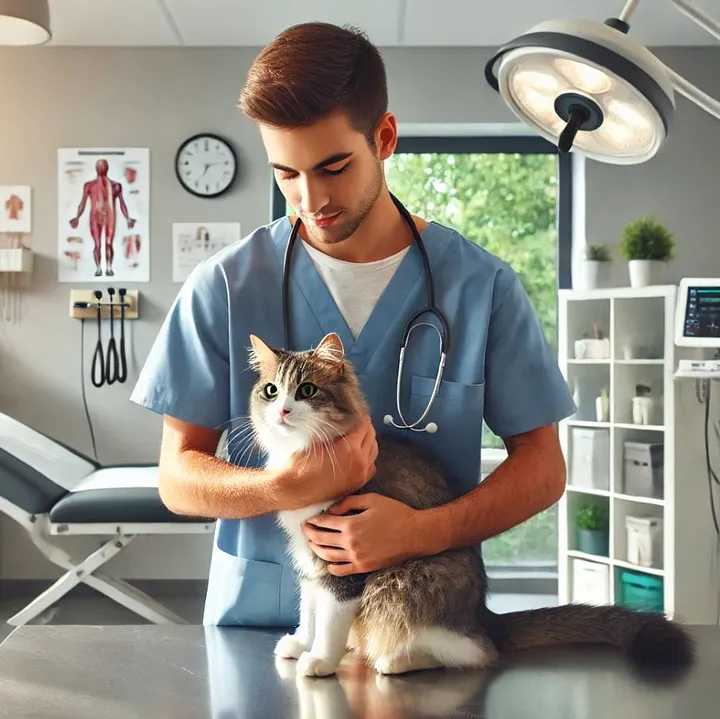Cats, like all pets, are prone to various health issues that require attention for early diagnosis and effective treatment. This guide explores common cat diseases, their symptoms, causes, and available treatments.
Cats are more than just pets—they’re cherished family members. As cat owners, it’s our responsibility to ensure their health and well-being. Like any other living creatures, cats can face health issues, and understanding common cat diseases is key to spotting early signs, seeking timely treatment, and ensuring your feline friend stays healthy.
In this blog, we’ll explore some of the most prevalent diseases in cats, their symptoms, causes, and treatment options to help you provide the best care possible for your furry companion.
1. Common Cat Diseases
a. Feline Upper Respiratory Infections (URIs)
URIs are the cat equivalent of the common cold, often caused by viruses like feline herpesvirus or calicivirus, and sometimes bacteria like Chlamydia felis. These infections spread easily, especially in multi-cat environments.
- Symptoms: Sneezing, nasal discharge, watery eyes, coughing, loss of appetite, and fever.
- Causes: Direct contact with infected cats or contaminated objects (e.g., bowls, bedding).
- Treatment: Rest, hydration, and medications (antibiotics or antivirals, depending on the cause). In severe cases, hospitalization may be required for supportive care.
b. Feline Diabetes
Feline diabetes is a metabolic disorder in which a cat’s body either doesn’t produce enough insulin or becomes resistant to it. This condition is common in older, overweight cats.
- Symptoms: Increased thirst, frequent urination, weight loss despite increased appetite, and lethargy.
- Causes: Obesity, genetic predisposition, or pancreatic issues.
- Treatment: Insulin injections, a veterinarian-prescribed diet, weight management, and regular glucose monitoring.
c. Feline Panleukopenia (Feline Distemper)
Feline panleukopenia is a highly contagious viral disease caused by the feline parvovirus. It primarily affects kittens and unvaccinated cats, attacking rapidly dividing cells in the body.
- Symptoms: Vomiting, diarrhea (sometimes bloody), fever, loss of appetite, and lethargy.
- Causes: Direct contact with infected cats or contaminated environments.
- Treatment: There’s no specific cure, but supportive care—such as fluids, antibiotics to prevent secondary infections, and anti-nausea medications—can help. Vaccination is crucial for prevention.
d. Feline Leukemia Virus (FeLV)
FeLV is a viral infection that suppresses a cat’s immune system, leaving them vulnerable to secondary illnesses. It spreads through saliva, nasal secretions, and shared items like food bowls or litter boxes.
- Symptoms: Persistent infections, anemia, swollen lymph nodes, weight loss, and pale gums.
- Causes: Close contact with infected cats or mother-to-kitten transmission.
- Treatment: While there’s no cure, treatment focuses on managing symptoms, maintaining a healthy lifestyle, and regular vet visits. Vaccination can prevent FeLV in at-risk cats.
e. Feline Kidney Disease
Chronic kidney disease (CKD) is a common condition in older cats where the kidneys gradually lose function over time.
- Symptoms: Increased thirst, excessive urination, weight loss, vomiting, bad breath, and poor coat condition.
- Causes: Aging, genetic predisposition, infections, or exposure to toxins.
- Treatment: Treatment includes a special kidney-friendly diet, fluid therapy, and medications to manage symptoms and slow disease progression.
2. How to Prevent Cat Diseases
Preventing cat diseases is often easier than treating them. Here are some proactive steps you can take:
- Vaccinations: Ensure your cat receives regular vaccinations against common diseases like FeLV, panleukopenia, and calicivirus.
- Routine Vet Check-ups: Regular check-ups help detect and address health issues early.
- Proper Nutrition: Feed your cat a balanced diet suitable for their age and health needs.
- Hygiene: Maintain a clean environment, including litter boxes, food dishes, and bedding.
- Parasite Control: Use flea, tick, and worm preventatives as recommended by your veterinarian.
3. When to See a Vet
It’s important to recognize the signs of illness in cats and seek veterinary care promptly. Look for symptoms such as:
- Sudden changes in appetite or weight.
- Persistent vomiting or diarrhea.
- Difficulty breathing or frequent sneezing.
- Lethargy or unusual hiding behavior.
- Abnormal discharge from the eyes, nose, or mouth.
If you notice any of these signs, schedule a visit to your veterinarian for a thorough evaluation.
4. Final Thoughts
Understanding cat diseases, their causes, and treatment options is crucial for being a responsible pet owner. While it’s natural to feel worried when your cat is unwell, early detection and proper care can make a significant difference in their recovery. By staying informed, providing preventative care, and working closely with your veterinarian, you can ensure your feline friend enjoys a happy, healthy life.
FAQs
1. What are the most common cat diseases?
The most common cat diseases include:
- Feline upper respiratory infections (URIs)
- Feline diabetes
- Feline leukemia virus (FeLV)
- Chronic kidney disease (CKD)
- Feline panleukopenia (feline distemper)
2. How can I tell if my cat is sick?
Signs that your cat may be sick include:
- Sudden changes in appetite or weight
- Vomiting or diarrhea
- Excessive thirst or urination
- Lethargy or hiding behavior
- Discharge from the eyes or nose
- Difficulty breathing
- Persistent coughing or sneezing
If you notice any of these symptoms, it’s best to consult your veterinarian.
3. How can I prevent my cat from getting sick?
You can prevent many illnesses by:
- Vaccinating your cat against common diseases like FeLV and feline distemper.
- Providing a healthy, balanced diet.
- Maintaining a clean environment.
- Regularly visiting the vet for check-ups.
- Using flea, tick, and worm preventatives as recommended by your vet.
4. What vaccines does my cat need?
Core vaccines for cats include:
- Rabies vaccine
- Feline distemper (panleukopenia)
- Feline herpesvirus (FHV-1)
- Feline calicivirus (FCV)
Your vet may also recommend non-core vaccines like FeLV based on your cat’s lifestyle.
